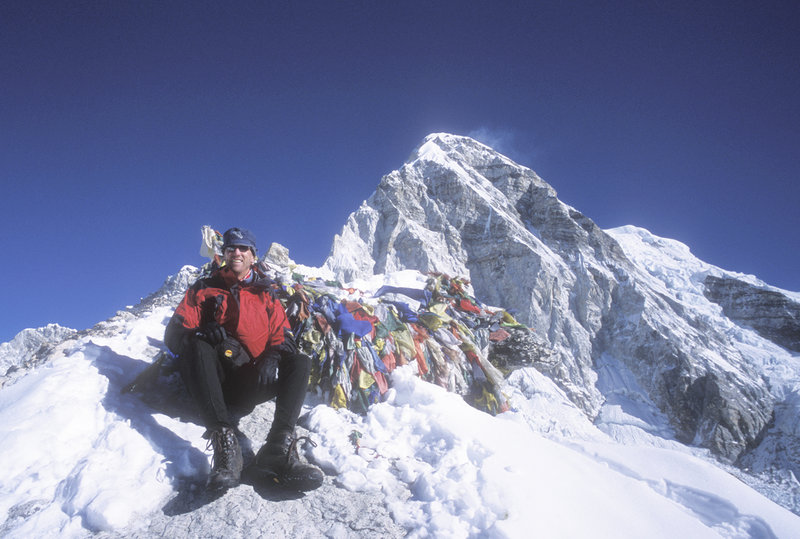When Bill Yeo attempted to summit Mount Everest in 2006, an infection in his lungs forced him to turn back and his failed attempt was met by questions.
But on Yeo’s trip up the world’s tallest peak, the Durham climber contributed more to the natural world he loves.
That’s because the research he conducted on 29,002-foot Mount Everest is being published worldwide this month, not only in scientific journals, but in major newspapers and magazines.
While ascending Everest, Yeo collected soil and snow samples over the course of seven weeks, and brought the samples back to the University of Southern Maine to analyze.
Yeo’s study showed conclusively that there were elevated concentrations of cadmium and arsenic in both the snow and the soil on Everest, and were highest in the snow, indicating the metal deposits were coming from the prevailing winds blowing from industrial smokestacks in China.
Professor Samantha Langley-Turnbaugh at the University of Southern Maine, who co-authored the study Yeo wrote on his findings, said his contribution to science as well as the attention it’s drawn is immeasurable.
“A lot of people have looked at changes in soil properties at elevations. Most of those studies have been done in places like Maine, looking at Katahdin or Bigelow and Sugarloaf. People have looked at soil studies on Himalayan peaks but not on Everest. Part of it is the environment is so harsh. And once you’ve collected the samples, you’ve got to carry them. And they’re not light,” said Langley-Turnbaugh.
Yeo gathered samples every 1,000 feet, starting at base camp, at 17,500 feet, all the way up to 25,200 feet.
As an environmental student at USM in 2006, and a lifelong environmentalist, Yeo wanted to study the metal deposits on the mountain.
He says his findings on the other side of the world reveal what is true everywhere.
“People don’t realize when they flip a switch, it’s tied into coal combustion in the Midwest,” Yeo said. “I wanted to do more, bring back hard evidence. There are studies that show the pollution in Asia affects people in the Caribbean. What we do here affects people on the other side of the world. People don’t realize we’re all on one planet.”
Similar studies have been done in the Himalayas as well as in New Zealand, Japan, Alaska and Antarctica. But Langley-Turnbaugh said none had been done on Everest, and few have been written about in major newspapers and magazines.
Since Yeo’s Everest study was published in “Soil Survey and Horizons” this fall, it has appeared this month in New Scientist in London, The Washington Post and The Hindu, India’s national newspaper.
“That’s the first time in my career that has happened,” said Langley-Turnbaugh, a faculty member since 1996. “It is exciting. And it’s really important that it got picked up.”
For Yeo, a farmer and Alpine guide who has lived off the land for 15 years, it’s part of a journey in environmental learning and education.
“Life is one big experiment,” he said with a smile. “I definitely see things I want to do, see things I want to change.”
He now hopes to get national grants to pursue similar studies, perhaps in Antarctica.
He also is working on starting an environmental building company that would teach businesses how to become more efficient and far gentler on the environment.
And Yeo says, he’s not done taking classes on new ways to learn about and help the environment.
“Bill is a really interesting guy,” said Langley-Turnbaugh, the head of USM’s environmental science department.
“When he talked about it after, he said everybody asked him if he was going to try again. And he said, ‘If I was going to devote so much of my life to that big a climb, I’d want to see somewhere different.’ Other climbers have had this obsession with getting to the top. But that’s not what Bill is about.”
Staff Writer Deirdre Fleming can be contacted at 791-6452 or at:
dfleming@pressherald.com
Copy the Story Link
Send questions/comments to the editors.



Success. Please wait for the page to reload. If the page does not reload within 5 seconds, please refresh the page.
Enter your email and password to access comments.
Hi, to comment on stories you must . This profile is in addition to your subscription and website login.
Already have a commenting profile? .
Invalid username/password.
Please check your email to confirm and complete your registration.
Only subscribers are eligible to post comments. Please subscribe or login first for digital access. Here’s why.
Use the form below to reset your password. When you've submitted your account email, we will send an email with a reset code.